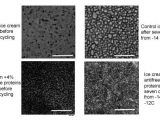Taste is more than chemical and connected to proper flavor. It implies signals of temperature and touch - what we call "mouth feeling" - and this is extremely important in the case of ice cream.
A smooth high quality ice cream has tiny ice crystals, around 15 to 20 microns wide. But temperature variation, like when bringing the ice cream home from the market, can make these crystals get over 40 microns wide, as a result of melting and refreezing water, and the ruined ice cream is crunchy. Currently, gum-like sugars are employed to combat this phenomenon, but they are far from 100 % effective.
The solution could be offered by the food chemist Srinivasan Damodaran at the University of Wisconsin-Madison, US. In his research published in the Journal of Agricultural and Food Chemistry, Damodaran comes with a much more effective edible antifreeze, made of gelatin and containing proteins like those enabling "snow fleas" to cope with freezing winter and "melt" unharmed.
Damodaran partly broke down gelatin proteins with the help of the proteolytic enzyme papain, existing in papaya. Through gel chromatography, he selected the smaller proteins resulting from the break down of the gelatin into various categories of weight.
These protein samples were added to samples of identical ice cream frozen at -40 ?C. The samples were investigated at this temperature and at -14?C to -12?C, from 3 to 21 minutes.
The smallest proteins were the most effective in impeding ice crystals from developing. When Damodaran assessed the amino acid composition and pattern of these proteins, he discovered they were almost identical to snow fleas, which can be active throughout the winter.
"The new antifreeze has similar physical properties and probably acts the same way," said Damodaran.
Yet, it will take some years for developing a new ice cream technology based on gelatin antifreeze, but it would come cheaper than other processes.
"Using gelatin as a source has the advantage of being easy to supply because it is a by-product of the meat and leather industries," said Andrew Wilbey, an ice-cream expert at Reading University, UK.
The European food company Unilever has developed engineered yeasts, synthesizing an antifreeze based on genes coming from Arctic fish blood, while a Canadian team focuses on antifreeze made of winter wheat.

 14 DAY TRIAL //
14 DAY TRIAL // 
